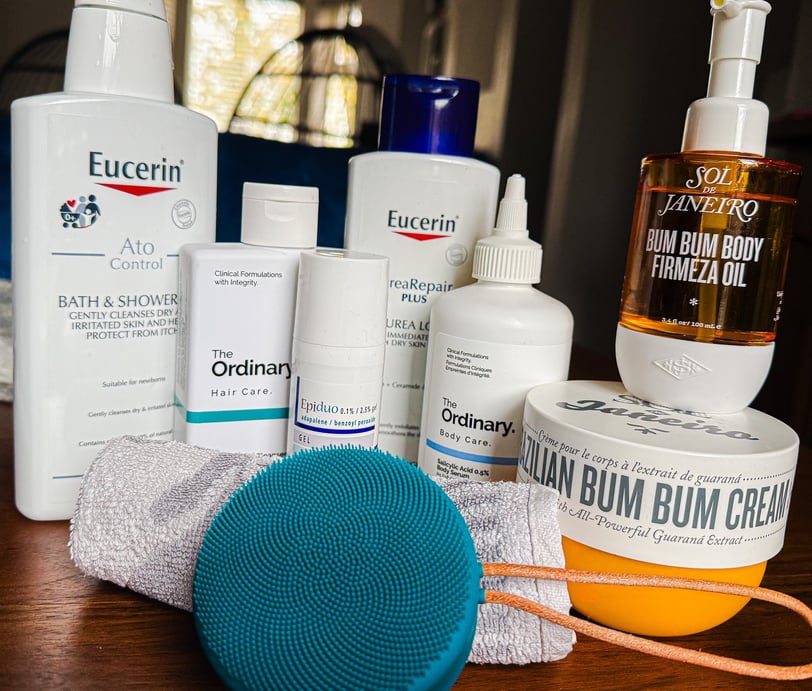Understanding Strawberry Skin: Keratosis Pilaris
Discover what strawberry skin, also known as keratosis pilaris, is and explore effective treatments to manage this common skin condition. Learn about causes, symptoms, and tips for smoother skin.
LONGEVITY & ANTI-AGING/WELL-AGING
11/7/20242 min read


What Is Keratosis Pilaris? Keratosis pilaris (KP) is a common, harmless skin condition that affects up to 40% of adults. Often called "strawberry skin" or "chicken skin," it appears as small, rough bumps typically on the upper arms, thighs, cheeks, or buttocks. These bumps form when keratin, a protein that protects skin, builds up and clogs hair follicles.
Common Symptoms:
Small, painless bumps resembling goosebumps
Rough, dry skin in affected areas
Light pink to red coloration
Sometimes mild itching
More noticeable in winter months
Often improves with age
Managing Keratosis Pilaris
Gentle Exfoliation The key is regular, gentle exfoliation to remove dead skin cells and excess keratin. Avoid harsh scrubbing, which can irritate the skin.
Recommended products by dermatologists:
Chemical exfoliants containing AHA (Alpha Hydroxy Acids) or BHA (Beta Hydroxy Acids)
Products with lactic acid or salicylic acid
Gentle exfoliating body washes
Moisturization Keeping skin hydrated is crucial for managing KP.
Products that could help to manage the condition:
Creams containing urea or ammonium lactate
CeraVe SA Lotion for Rough & Bumpy Skin
AmLactin Daily Moisturizing Body Lotion
First Aid Beauty KP Bump Eraser Body Scrub
Sol de Janeiro Bum Bum cream and oil
Epiduo
Eucerin Ato shower oil
Eucerin Urea Repair Plus body cream
The Ordinary 0.5% Salicylic Acid Body Serum
Loofah
Foreo LUNA™ 4 Body T-Sonic™ Massaging Body Brush for All Skin Types
Professional Treatments For persistent cases:
Chemical peels
Laser hair removal
Microdermabrasion
Daily Care Routine:
Gentle exfoliation (2-3 times per week)
Apply treatment products containing AHA/BHA
Use thick moisturizer
Additional Tips:
Take warm (not hot) showers
Pat skin dry instead of rubbing
Apply moisturizer to damp skin
Stay hydrated
Consider using a humidifier
Avoid tight clothing that can irritate skin
Natural Remedies:
Coconut oil for moisturizing
Apple cider vinegar diluted as a toner
Dry brushing (very gently)
Fish oil supplements for skin health
When to See a Dermatologist:
If symptoms worsen
If over-the-counter treatments aren't effective
If the condition causes significant distress
If you develop infection signs
Important Notes:
Results take time; be patient and consistent
What works for one person may not work for another
Avoid picking or scratching at the bumps
The condition may flare up seasonally
There's no permanent cure, but symptoms can be managed effectively
Remember: Keratosis pilaris is a genetic condition and not related to poor hygiene. While it can be frustrating, it's completely harmless and often improves with age. The key to management is finding the right combination of treatments that work for your skin and maintaining a consistent care routine.
Disclaimer: This article is for informational purposes only and should not be considered medical advice. Always consult with a healthcare professional for diagnosis and treatment of medical conditions.
Optimize Your Health with Cutting-Edge Biohacking Research and Tech Wearable
© 2024. All rights reserved.
The content on this website is intended for informational purposes only and should not be considered as professional advice. It is not a substitute for personalized medical, nutritional, or fitness guidance. Please do not make any changes to your lifestyle, diet, or exercise routine based on the information provided here without first consulting with your healthcare provider. Always seek the advice of a qualified professional before implementing any new practices or treatments discussed on this site. Your health and safety are our top priority.


